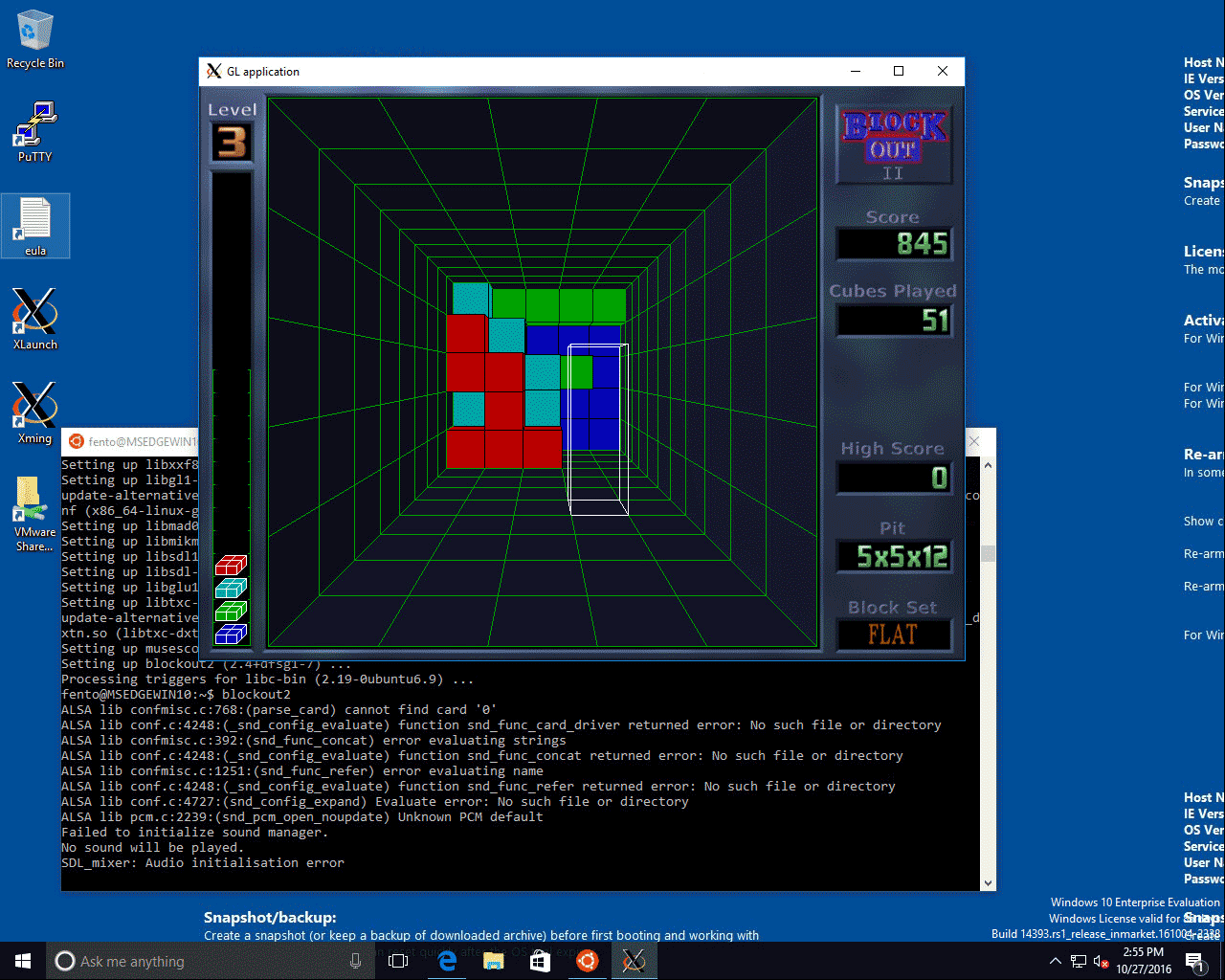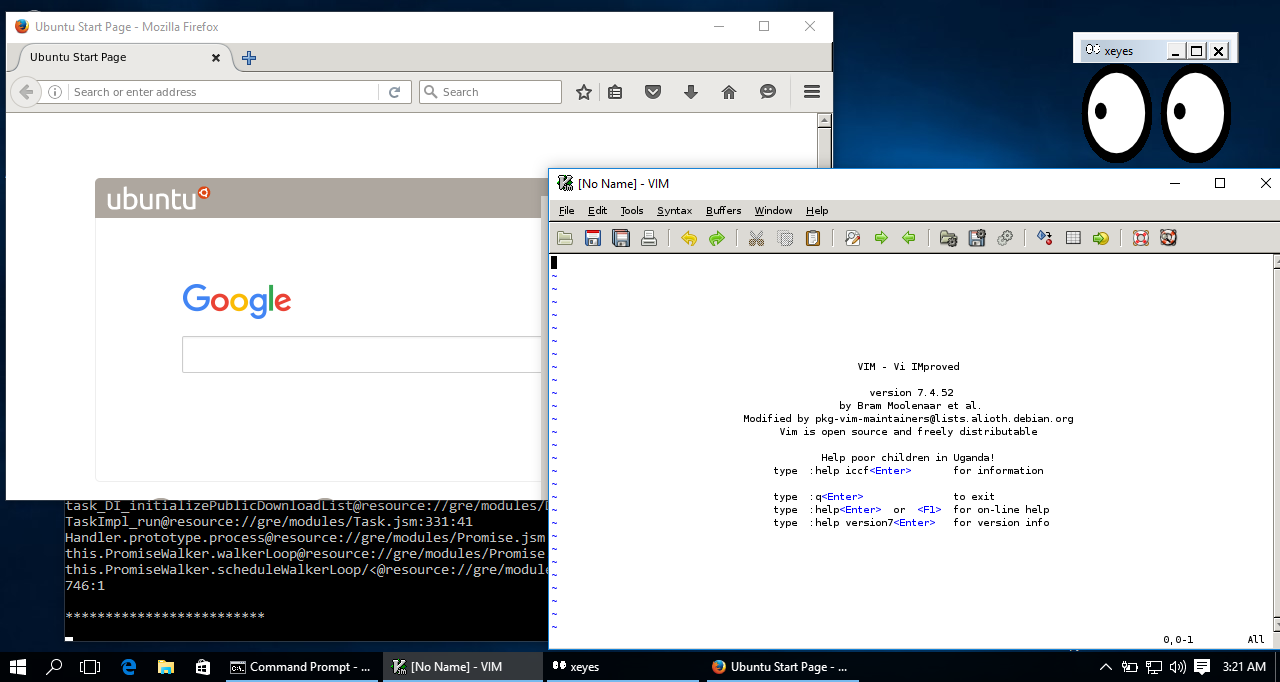http://invisible-island.net/
Copyright © 1996-2019,2020 by Thomas E. Dickey
- Xterm Client For Windows 10
- Xterm For Windows 10
- Xterm Client For Windows
- Xterm Emulator For Windows 10
- Xterm Windows 10 Indir
- Xterm For Windows 10 Free Download
Supportads.weebly.com Xterm For Windows 10 64 MobaXterm is a set of Unix commands (GNU/Cygwin) included in a single portable exe file. MobaXterm integrates an X server and many network clients (SSH, RDP, VNC, telnet, rlogin, sftp, ftp.) accessible through a tab-based terminal. Terminal emulators are used to access the command-line interface. A good terminal emulator for Windows will be customizable both in its utility and aesthetics, offer lots of functionality and integrate well with Windows. Some common things to expect from a modern Windows terminal emulator include tabs, split panes, theming, transparency, quake-style dropdown graphic mode.
- History
- Related Links

X410 is based on the X.Org open-source project that has been actively developed and maintained far before Windows 10. But, unlike the original X.Org project that even supports Windows XP, X410 only supports Windows 10; it doesn't need to worry about compatibility with previous Windows versions, and more importantly, it can freely make use of the new features available in Windows 10. In computing, xterm is the standard terminal emulator for the X Window System. A user can have many different invocations of xterm running at once on the same display, each of which provides independent input/output and each in fact simulating a physical standalone terminal. Xterm originated prior to the X Window System. System Thomas Dickey is the maintainer/developer of xterm, the standard terminal emulator for the X Window System. This page gives some background and pointers to xterm resources.
Synopsis
The xterm program is a terminal emulator for the X Window System. It provides DEC VT102 and Tektronix 4014 compatible terminals for programs that can't use the window system directly.
This version implements ISO/ANSI colors using the 'new' color model (i.e., background color erase). It also implements most of the control sequences for VT220, as well as selected features from other DEC terminals such as VT320, VT420 and VT520.
History


Xterm Client For Windows 10
I decided to work on xterm in early 1995, to support ded and add (and incidentally ncurses) in the X environment. Several people had made modifications to xterm to support color, but none (except for the completely independent rxvt) implemented background color erase. That is rather like preferring MS-DOS to UNIX. Completely mystifying.
Being bogged down in ncurses, I didn't get involved in xterm until the very end of 1995, after working on atac.
I implemented a workable version of colorized xterm just at the point where XFree86 3.1.2B was announced, complete with a color xterm. As luck would have it, they'd incorporated the 'old' color model. So I joined the XFree86 project to fix it.
As I learned more about xterm, I realized that it implemented part of VT220 (i.e., the locking shifts for extended character sets). Since a number of people on the Internet are looking for a good VT220 emulator, it seemed a natural follow-on project to make xterm a good VT220 emulator. By the release of XFree86 3.2, I had implemented most of the control sequences, except for a handful (DECSTR, the KAM and SRM modes, the ones pertaining to doublesize and soft characters, and of course, blink).
XTerm FAQ
The XTerm FAQ gives more information, showing how to resolve problems with it, as well as contrasting xterm with other terminals.
XTerm Change Log
The CHANGE LOG shows when and why features were added or changed.
See Also
See this discussion of the icons used for xterm.
To support xterm, I also work on vttest.
luit allows xterm to support character encodings other than ISO-8859-1 and UTF-8.
Xterm For Windows 10
X Toolkit provides xterm with support for X resources.
Download
Related links
Xterm Client For Windows

Xterm Emulator For Windows 10
There are numerous references on the net to xterm. Here are a few of the more interesting ones:
Xterm Windows 10 Indir
Packages for XTerm:
OSWatershed.org (archived 2014)
OpenCSW and UnixPackages (Solaris)
Discussion of XTerm's features:
Historical sources:
Archive of snapshots (see discussion).
I export to this on completing a patch update.
I began the archive with patch #50 (1997/8/22).
While I have the earlier patches and mail, the XFree86 mailing list archives are not available.XFree86 archives have commits for my patches from 1996 to 2006.
I made my own commits to XFree86 CVS for patch #149 through #215.
These developers have copies of the XFree86 CVS (see mailing list):Prior to XFree86, the X Consortium maintained RCS archives.
Alan Coopersmith has a copy of that (seen here).X11 release versions of xterm, from the distribution tarballs.
When you need X410, you can effortlessly install it from Microsoft Store. You don't even need to worry about updating X410 to its latest version; Windows 10 automatically keeps it up to date!
Once X410 is installed, it's ready to be used with Windows Subsystem for Linux (WSL), SSH X11 forwarding or in any situation that needs an X-Window server. We carefully prepared the default settings in X410 to accommodate most usage cases, but you can of course easily adjust them to fit your workflow.
No longer need to use X410? No problem! Just click 'Uninstall' from the right-click popup menu for X410 on Start screen.
X410 is published after it's certified by Microsoft for compatibility and content. It's also digitally signed when it's delivered to your Windows 10 via Microsoft Store. Hence you have fewer things to worry about X410 when it comes to malicious codes and viruses.
X410 is based on the X.Org open-source project that has been actively developed and maintained far before Windows 10. But, unlike the original X.Org project that even supports Windows XP, X410 only supports Windows 10; it doesn't need to worry about compatibility with previous Windows versions, and more importantly, it can freely make use of the new features available in Windows 10.
X410 is and will be constantly streamlined and optimized just for Windows 10!
When you launch X410, it behaves like a normal Windows app rather than a full-blown graphical display server that takes over Windows user interface. X410 also runs snappier and consumes less system resources than traditional X-Window servers.
Are you using a 4K monitor? No problem! X410 natively supports HiDPI screens; it enables you to get crisply scaled Linux GUI apps simply by activating the scaling feature found in popular Linux GUI toolkits such as GTK and Qt.
X410 supports sharing clipboard between Windows and Linux; when you copy text to clipboard in Windows, you can seamlessly paste it to Linux GUI apps and vice versa. Along with plain text, X410 also supports transferring images (BMP/PNG) and HTML text via clipboard.
X410 has two seamless integration modes, Windowed Apps and Desktop. If you want to use your Linux GUI apps individually side by side with normal Windows apps, choose the Windowed Apps mode. In this mode, X410 activates its own window manager for Linux GUI apps that enables you to position and resize the apps along with Windows apps. If you want to experience more immersive and comprehensive Linux GUI desktop environment such as Xfce4, choose the Desktop mode.
Do you want to open Linux GUI apps from the Docker Console in Token2Shell? Just run X410 and you're ready! You don't need to change any setting, simply install your favorite GUI apps and use them as if you're on a Linux machine. X410 also works flawlessly over SSH connections with X11 forwarding.